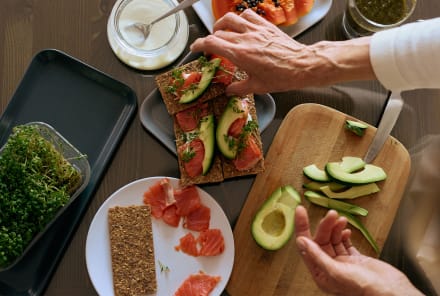Advertisement
The Vata Dosha: How To Eat, Exercise & De-Stress To Keep It In Check


According to the ancient medicine, each dosha has its own qualities and characteristics, and we tend to feel the best when they all exist in balance in the body. However, most of us are dominant in one or two of the doshas and need to adjust our daily routines accordingly. (Not sure which dosha you are? This dosha quiz will help you find out.)
Here's everything you need to know about the airy vata dosha and how to keep it in balance using food, movement, and lifestyle shifts.
What vata means:
In Sanskrit, vata translates to 'wind,' which makes sense when you consider that this is the dosha associated with flow and movement in the body and mind.
It controls the circulation of blood, flow of breath, movement of limbs and muscles, and the expression of speech. It's also a motivating force behind the other two doshas: without the movement inherent to vata, both pitta and kapha become essentially inert.
Vata qualities and characteristics:
Here are some of the main qualities of this dosha:
- Cold
- Dry
- Light
- Rough
- Mobile
Those who are vata-dominant tend to think quickly on their feet and be creative, dynamic, and flexible. They tend to speak quickly and can easily veer off-topic. Though they often have bubbly personalities, vatas are prone to anxiety and worry.
Vata body type:
Vatas tend to be naturally thin, with small frames and a narrow build. "Vata manifests in the physical realm as subtlety—fine or sharp features, small eyes, thin bones, and skin," explains Milla Stanton, an ayurvedic health educator. "Vata individuals may have protruding bone structure and have a difficult time gaining weight," she adds.
Signs of a vata imbalance:
Too much vata in the body can make people feel ungrounded and erratic. In Ayurveda, signs of a vata imbalance include trouble sitting still, anxiety, insomnia, dry skin, and digestive issues like gas, bloating, loss of appetite, constipation, and irregular elimination.
Periods of too much stimulation or movement, like prolonged commutes or stressful workweeks, can exacerbate these symptoms.
How to balance vata:
The best way to balance vata is with grounding practices and warm, comforting routines. Think regular massages, calming bedtime rituals, and daily meditation practices.
A consistent routine will help those who are vata dominant slow down, ensure that they don't skip meals, and help them get to bed on time. Listening to relaxing music, spending time in nature, and taking intentional breaks from screens (especially before bed) can also help those who have an excess of vata feel thier best.
Eating and drinking for vata:
Vata is dry, cool, and light, and foods that are oily, warming, and heavy offer some balance to promote proper digestion.
Eating for your dosha can go a long way in keeping you feeling great, but keep in mind that this kind of intentional eating is more a practice and less a list of hard-and-fast rules. Here is an overview of the Ayurvedic diet.
Foods to eat:
- Foods that are salty, sweet, and sour
- Rice, whole wheat, and oats
- Sweet, heavy fruits like avocado, banana, mango, plums, berries, and peaches
- Cooked vegetables to aid digestion
- Warming spices like cardamom, cumin, ginger, cinnamon, cloves, fennel, and sage
- Natural sweeteners like maple syrup and honey (but use them sparingly)
Foods to avoid:
- Pungent, bitter, astringent foods
- Barley, corn, rye
- Light, dry fruits like apples, pears, and pomegranates
- Raw vegetables, and those with a lot of seeds
- Black beans, chickpeas, and kidney beans
- White sugar, most liquors, and coffee
"It's best to eat three meals during the day," Stanton adds, "because vata digestion can be delicate." Meals should also be served warm, and beverages are best enjoyed at room temperature or warm—not iced!
Best exercises for vata:
Vatas may be drawn to exercises with a lot of movement, but they should opt for a slower approach. "Vata needs exercise that creates stability, strength, and stamina," says Marie Harger, an ayurvedic health practitioner, "but you need to be careful not to overdo it." Balance the energy and lightness of vata with weight-bearing exercises that are intentional and grounding, such as restorative yoga and yoga sequences with longer holds. Savasana is a particularly good thing for vata-dominant people to practice.
The bottom line:
When the energetic, creative vata dosha becomes unbalanced, it can manifest as restlessness, anxiety, and insomnia. Bringing more warmth and stability into your life could be the key to equilibrium for those who are dominant in vata.
Watch Next
Enjoy some of our favorite clips from classes
Enjoy some of our favorite clips from classes
What Is Meditation?
Mindfulness/Spirituality | Light Watkins
Box Breathing
Mindfulness/Spirituality | Gwen Dittmar
What Breathwork Can Address
Mindfulness/Spirituality | Gwen Dittmar
The 8 Limbs of Yoga - What is Asana?
Yoga | Caley Alyssa
Two Standing Postures to Open Up Tight Hips
Yoga | Caley Alyssa
How Plants Can Optimize Athletic Performance
Nutrition | Rich Roll
What to Eat Before a Workout
Nutrition | Rich Roll
How Ayurveda Helps Us Navigate Modern Life
Nutrition | Sahara Rose
Messages About Love & Relationships
Love & Relationships | Esther Perel
Love Languages
Love & Relationships | Esther Perel


















